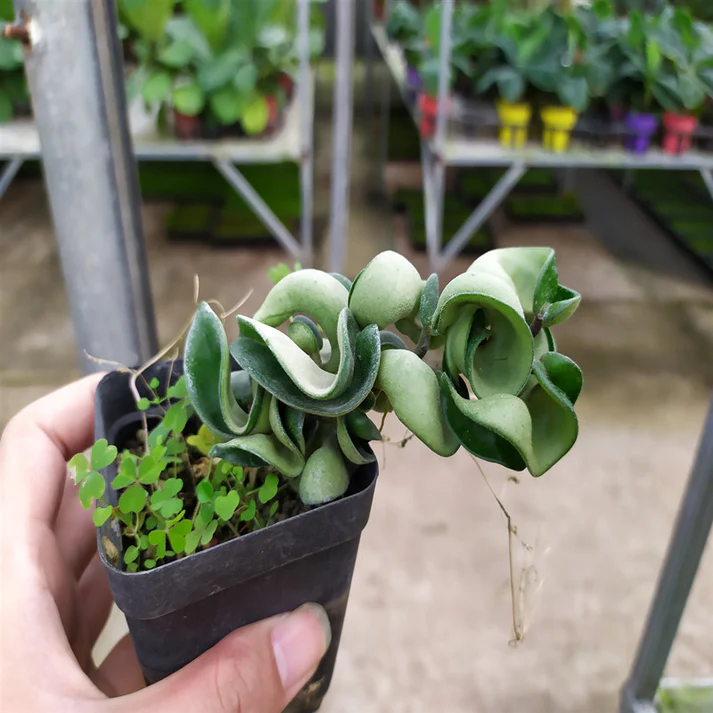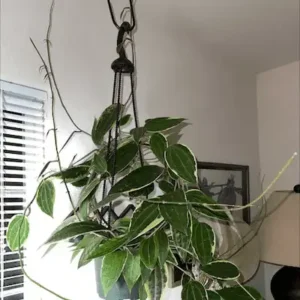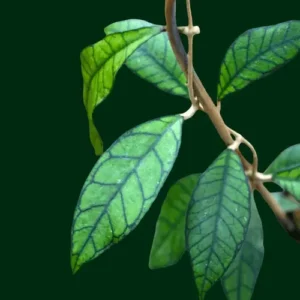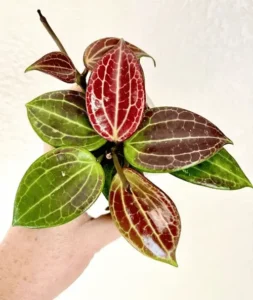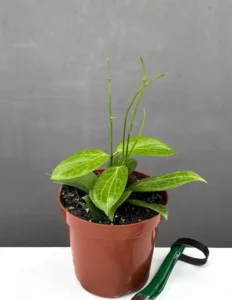Curly Hoya Plant (Hoya carnosa compacta), also known as the Hindu Rope Plant. Here’s a detailed guide about curly hoya plant care. It is fairly easy, especially once you understand its needs. With its tolerance for lower humidity and ability to thrive when slightly root-bound, the Curly Hoya is a perfect plant for both beginners and seasoned plant enthusiasts alike.
Analysis of curly hoya plant care tips
Here is a detailed analysis of curly hoya plant care tips.
1. Light
-Bright, indirect light
It is ideal for optimal growth and flowering. This curly hoya plant can handle some direct sunlight but avoid long hours of harsh afternoon sun, which can scorch its leaves. If your hoya plant isn’t blooming, it may need more light. Consider a sunny window or even a grow light if needed.
2. Watering
-Let the soil dry out between waterings
-The Curly Hoya is semi-succulent, meaning it stores water in its thick leaves, making it drought-tolerant.
-Overwatering
-It is a common mistake, leading to root rot. Water thoroughly, but allow the top 2 inches (5 cm) of soil to dry out before watering again.
-Reduce watering in winter
-Reduce watering in winter when the plant’s growth slows down.
3. Humidity
-Provide moderate to high humidity
-Curly Hoyas thrive in moderate to high humidity (40-60%). If your indoor air is dry, especially in winter, consider using a humidifier or placing the plant near a tray of water and pebbles to increase humidity.
-Regular misting can help but don’t overdo it, as stagnant moisture on the leaves can cause fungal issues.
4. Soil
-Use a well-draining potting mix
-A mix designed for succulents or orchids is ideal, as it allows excess water to drain while retaining some moisture.
-You can also create your blend by mixing regular potting soil with perlite, orchid bark, or coco coir for better drainage.
5. Temperature
-Hoyas prefer warm temperatures
-These wax plants prefer warm temperatures, ideally between 60-80°F (16-27°C). They do not tolerate frost, so avoid placing them in drafty or cold areas.
-Keep them away from cold windows, especially during winter, and avoid placing them near heating vents that could dry them out.
6. Fertilizing
-Balanced liquid fertilizer
-During the growing season (spring and summer), fertilize your Curly Hoya once a month with a balanced liquid fertilizer diluted to half strength.
-Avoid fertilizing in winter when the Hoya (plant) is not actively growing.
7. Repotting
-Slightly root-bound
-Hoyas like being slightly root-bound, so repotting isn’t needed frequently. You can repot every 2-3 years, or when you notice the roots growing out of the drainage holes.
-When repotting, choose a pot that’s just one size larger than the current one and ensure it has drainage holes.
8. Pruning
-Pruning requirements
-Pruning isn’t necessary unless you want to control the size or shape. Trim back leggy or overgrown vines if desired.
-Avoid cutting the flower spurs (the small nubs where flowers grow), as the plant will rebloom from these areas in the future.
9. Propagation
-Stem cuttings
-Curly Hoyas can be easily propagated through stem cuttings. Cut a healthy vine with a few nodes, let the cut end dry for a day, and then place it in water or moist soil until roots develop.
10. Pests
-Mealybugs, aphids, or spider mites
-Curly Hoyas are relatively pest-resistant but can occasionally attract mealybugs, aphids, or spider mites. Wipe down the leaves regularly and inspect for pests. Treat infestations with insecticidal soap or neem oil.
11. Flowering
-Flowering requirements
-Hoyas bloom best when they receive bright, indirect light and are slightly pot-bound.
-Patience is key—flowering can take a couple of years, but once they start, they often bloom annually.
FAQs How to grow curly hoya? Curly hoya grows in bright, indirect sunlight with stable room temperatures of 60-80°F (16-27°C). However, for enough growth, provide moderate to high humidity below 60. Do hoya plants need sun? These wax plants prefer bright, indirect sunlight. In case of direct sunlight, these wax plants will automatically die. Their leaves will be scorched, wilted, or turned yellow. Is the Hoya plant good for home? The Hoya plant. also known as the wax plant due to its waxy leaves is a better choice for indoor gardening if you are looking for an easy-to-care houseplant. |
Conclusion
In conclusion, the Curly Hoya (Hoya compacta “Hindu Rope”) is a visually striking and low-maintenance houseplant that can thrive with the right care. Its unique twisted foliage and occasional clusters of waxy flowers make it a wonderful addition to any indoor space. However, by providing it with bright, indirect light, well-draining soil, and moderate watering, along with a little patience, you can enjoy its slow-growing beauty for years. By following these care tips, your Curly Hoya will grow healthy and might reward you with its beautiful clusters of waxy, star-shaped flowers.

